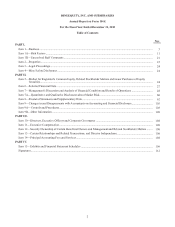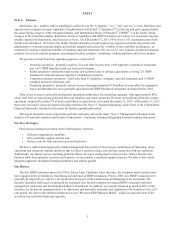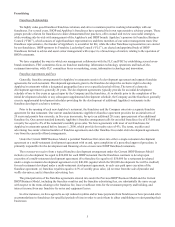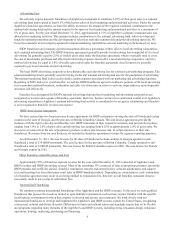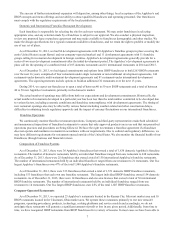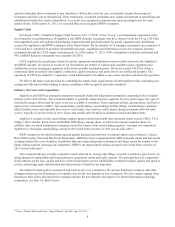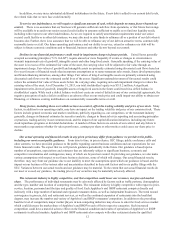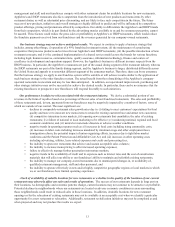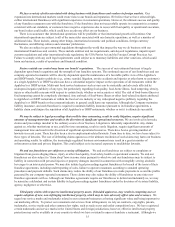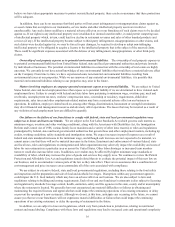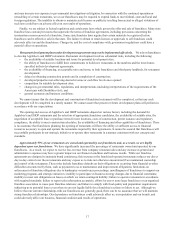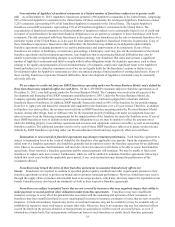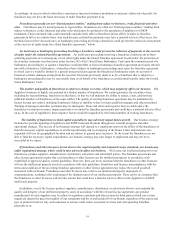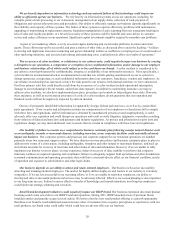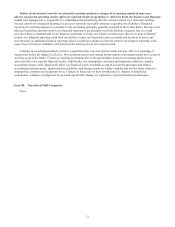IHOP 2013 Annual Report Download - page 33
Download and view the complete annual report
Please find page 33 of the 2013 IHOP annual report below. You can navigate through the pages in the report by either clicking on the pages listed below, or by using the keyword search tool below to find specific information within the annual report.12
In addition, we may incur substantial additional indebtedness in the future. If new debt is added to our current debt levels,
the related risks that we now face could intensify.
To service our indebtedness, we will require a significant amount of cash, which depends on many factors beyond our
control. There is no assurance that our business will generate sufficient cash flow from operations, or that future borrowings
will be available to us under our senior secured credit facility in amounts sufficient to enable us to fund our liquidity needs,
including with respect to our other indebtedness. As we are required to satisfy amortization requirements under our senior
secured credit facility or as other debt matures, we may also need to raise funds to refinance all or a portion of our debt when it
becomes due. Further, there is no assurance that we will be able to refinance any of our debt on attractive terms, commercially
reasonable terms or at all. Our future operating performance and our ability to service, extend or refinance our debt will be
subject to future economic conditions and to financial, business and other factors beyond our control.
Declines in our financial performance could result in impairment charges in future periods. United States generally
accepted accounting principles (“U.S. GAAP”) require annual (or more frequently if events or changes in circumstances
warrant) impairment tests of goodwill, intangible assets and other long-lived assets. Generally speaking, if the carrying value of
the asset is in excess of the estimated fair value of the asset, the carrying value will be adjusted to fair value through an
impairment charge. Fair values of goodwill and intangible assets are primarily estimated using discounted cash flows based on
five-year forecasts of financial results that incorporate assumptions as to same-restaurant sales trends, future development plans
and brand-enhancing initiatives, among other things. Fair values of long-lived tangible assets are primarily estimated using
discounted cash flows over the estimated useful lives of the assets. Significant underachievement of forecasted results could
reduce the estimated fair value of these assets below the carrying value, requiring non-cash impairment charges to reduce the
carrying value of the asset. As of December 31, 2013, our total stockholders' equity was $315.2 million. A significant
impairment write-down of goodwill, intangible assets or long-lived assets in the future could result in a deficit balance in
stockholders' equity. While such a deficit balance would not create an event of default in any of our contractual agreements, the
negative perception of such a deficit could have an adverse effect on our stock price and could impair our ability to obtain new
financing, or refinance existing indebtedness on commercially reasonable terms or at all.
Many factors, including those over which we have no control, affect the trading volatility and price of our stock. Many
factors, in addition to our operating results, may have an impact on the trading volatility and price of our common stock. These
factors include general economic and market conditions, publicity regarding us, our competitors, or the restaurant industry
generally, changes in financial estimates by securities analysts, changes in financial or tax reporting and accounting principles
or practices, trading activity in our common stock, and the impact of our capital allocation initiatives, including any future
stock repurchase programs or dividend declarations. A number of these factors are outside of our control, and any failure to
meet market expectations whether for sales growth rates, earnings per share or other metrics could cause our share price to
decline.
Our actual operating and financial results in any given period may differ from guidance we provide to the public,
including our most recent public guidance. From time to time, in press releases, SEC filings, public conference calls and
other contexts, we have provided guidance to the public regarding current business conditions and our expectations for our
future financial results. We expect that we will provide guidance periodically in the future. Our guidance is based upon a
number of assumptions, expectations and estimates that are inherently subject to significant business, economic and
competitive uncertainties and contingencies, many of which are beyond our control. In providing our guidance, we also make
various assumptions with respect to our future business decisions, some of which will change. Our actual financial results,
therefore, may vary from our guidance due to our inability to meet the assumptions upon which our guidance is based and the
impact on our business of the various risks and uncertainties described in these risk factors and in our public filings with the
SEC. Variances between our actual results and our guidance may be material. To the extent that our actual financial results do
not meet or exceed our guidance, the trading prices of our securities may be materially adversely affected.
The restaurant industry is highly competitive, and that competition could lower our revenues, margins and market
share. The performance of individual restaurants may be adversely affected by factors such as traffic patterns, demographics
and the type, number and location of competing restaurants. The restaurant industry is highly competitive with respect to price,
service, location, personnel and the type and quality of food. Each Applebee's and IHOP restaurant competes directly and
indirectly with a large number of national and regional restaurant chains, as well as independent businesses. The trend toward
convergence in grocery, deli, and restaurant services, as well as the continued expansion of restaurants into the breakfast
daypart, may increase the number and variety of Applebee's and IHOP restaurants' competitors. In addition to the prevailing
baseline level of competition, major market players in non-competing industries may choose to enter the food services market
which could decrease the market share of Applebee's and IHOP in each of their respective categories. Such increased
competition could have a material adverse effect on the financial condition and results of operations of Applebee's or IHOP
restaurants in affected markets. Applebee's and IHOP restaurants also compete with other restaurant chains for qualified


